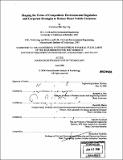| dc.contributor.advisor | Kenneth A. Oye. | en_US |
| dc.contributor.author | Ng, Christine Bik-Kay, 1979- | en_US |
| dc.contributor.other | Massachusetts Institute of Technology. Technology, Management, and Policy Program. | en_US |
| dc.date.accessioned | 2007-11-15T19:53:06Z | |
| dc.date.available | 2007-11-15T19:53:06Z | |
| dc.date.copyright | 2006 | en_US |
| dc.date.issued | 2006 | en_US |
| dc.identifier.uri | http://dspace.mit.edu/handle/1721.1/34619 | en_US |
| dc.identifier.uri | http://hdl.handle.net/1721.1/34619 | |
| dc.description | Thesis (Ph. D.)--Massachusetts Institute of Technology, Engineering Systems Division, Technology, Management, and Policy Program, 2006. | en_US |
| dc.description | Includes bibliographical references. | en_US |
| dc.description.abstract | Environmental regulations are typically portrayed as an outside force stimulating development of environmental technologies in regulated industries. In reality, firms influence regulation by communicating their technological progress, which helps form a basis for future standards. Because of differences in each firm's technological capability and environmental performance, regulations affect the competitive position of firms. Firms with advanced technologies stand to gain competitive benefit from more stringent environmental regulations, and may therefore choose to introduce a more costly but cleaner technology ahead of regulation. Such a competitive regulatory strategy has the potential to bring competitive benefits to the lead firm(s) and environmental benefits to the public. This research explains the conditions under which competitive regulatory strategies are pursued in the diesel vehicle and fuel industry. Growing public concern about the health effects of diesel exhaust has led countries to implement several cycles of increasingly stringent emission and fuel regulations over the past two decades. | en_US |
| dc.description.abstract | (cont.) Taking a comparative case study approach, this work studies multiple regulatory cycles for light-duty vehicles, heavy-duty engines, and diesel fuel sulfur in the European Union, Japan, and the United States. For each region's regulatory cycles, cases of corporate behavior, including early adoption, first-mover behavior, and noncompliance, are identified and analyzed for their context, motivation, influence on regulatory policy, and public and private effects. Source material consists of documentary sources, descriptive statistics, and semi-structured interviews with experts. This methodology generates multiple cases for comparison across countries, cycles, sectors, and firms. While early- and first-mover behavior was observed in the regulatory cycles, firms do not aggressively pursue competitive regulatory strategies. They are guided by other motivations, such as fiscal incentives, diesel market share protection, and technology development/testing. A weak business case, risk aversion, industry pressure, and lack of supporting infrastructure pose strong disincentives. | en_US |
| dc.description.abstract | (cont.) The final recommendations address issues pertinent to regulators, firms, and environmental groups: fiscal incentives as an effective means to encourage rapid technology adoption; environmental NGOs as a vehicle for communicating technological progress; use of technology demonstrations by lead firms to show regulatory readiness; and combination of short-term and long-term targets with mechanisms to encourage technology-based competition. | en_US |
| dc.description.statementofresponsibility | by Christine Bik-Kay Ng. | en_US |
| dc.format.extent | 343 p. | en_US |
| dc.language.iso | eng | en_US |
| dc.publisher | Massachusetts Institute of Technology | en_US |
| dc.rights | M.I.T. theses are protected by copyright. They may be viewed from this source for any purpose, but reproduction or distribution in any format is prohibited without written permission. See provided URL for inquiries about permission. | en_US |
| dc.rights.uri | http://dspace.mit.edu/handle/1721.1/34619 | en_US |
| dc.rights.uri | http://dspace.mit.edu/handle/1721.1/7582 | |
| dc.subject | Technology, Management, and Policy Program. | en_US |
| dc.title | Shaping the terms of competition : environmental regulation and corporate strategies to reduce diesel vehicle emissions | en_US |
| dc.title.alternative | Environmental regulation and corporate strategies to reduce diesel vehicle emissions | en_US |
| dc.type | Thesis | en_US |
| dc.description.degree | Ph.D. | en_US |
| dc.contributor.department | Massachusetts Institute of Technology. Engineering Systems Division | |
| dc.contributor.department | Technology and Policy Program | |
| dc.identifier.oclc | 71331635 | en_US |
